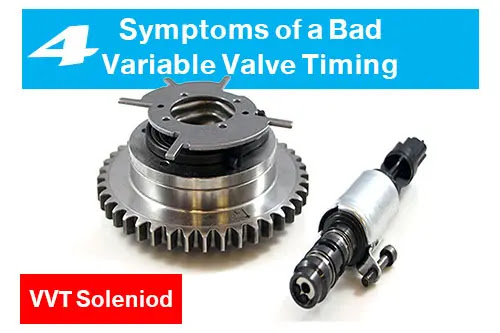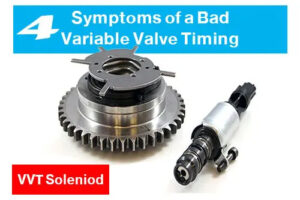4 Symptoms of a Bad or Failing Variable Valve Timing Solenoid VVT

Variable Valve Timing, also known as (VVT Solenoid), is a revolutionary technology that has transformed the automotive industry. This system plays a crucial role in optimizing engine performance and fuel efficiency by precisely adjusting the timing of the camshafts. As a result, it allows for improved power output, reduced emissions, and enhanced overall driving experience.
How Variable Valve Timing Works
At its core, Variable Valve Timing is designed to control the opening and closing of the engine’s valves. The camshafts, which are responsible for operating the valves, have their positions adjusted based on the engine’s operating conditions. This adjustment is made possible by the VVT system, which consists of various components working together seamlessly.
In a typical VVT engine, the camshaft’s position is altered using a mechanism called a camshaft actuator or phaser. This actuator is controlled by a solenoid, known as the VVT solenoid, which regulates the flow of oil pressure to the actuator. By manipulating the oil pressure, the VVT system can advance or retard the camshaft’s timing, optimizing valve operation.
Benefits of Variable Valve Timing
The implementation of Variable Valve Timing brings numerous advantages to modern engines. Let’s explore some of the key benefits:
Enhanced Fuel Efficiency: Variable Valve Timing optimizes the combustion process by ensuring that the valves open and close at the most opportune moments. This leads to improved fuel efficiency, as the engine can extract more energy from each drop of fuel.
Reduced Emissions: The precise control over valve timing provided by VVT helps to minimize emissions, particularly during startup and at low engine speeds. By optimizing the air-fuel mixture, the engine can operate more cleanly and meet stringent environmental regulations.
Smooth Idle and Low-End Torque: Variable Valve Timing allows for better control of the engine’s idle speed and low-end torque. This results in a smoother and more responsive driving experience, particularly during city driving and stop-and-go traffic.
Common Symptoms of a Faulty VVT Solenoid
While Variable Valve Timing systems offer significant advantages, they can experience issues over time. One critical component that can fail is the VVT solenoid. Here are some common symptoms of a faulty VVT solenoid:
Illuminated Check Engine Light: When the VVT solenoid fails, it triggers the vehicle’s onboard diagnostics system, leading to the illumination of the check engine light. This serves as an early warning sign of potential issues with the Variable Valve Timing system.
Rough Engine Performance: A malfunctioning VVT solenoid can disrupt the precise timing of the camshaft, resulting in rough engine performance. This may manifest as rough idle, misfires, or a noticeable decrease in power and acceleration.
Engine Noise: A faulty VVT solenoid can cause unusual engine noises, such as rattling or ticking sounds. These noises may occur when the solenoid fails to supply the necessary oil pressure to the camshaft actuator.
Decreased Fuel Efficiency: If the VVT solenoid is not functioning correctly, it can negatively impact fuel efficiency. The engine may consume more fuel than usual due to improper valve timing, leading to decreased mileage per gallon.
If you experience any of these symptoms, it is crucial to have your vehicle inspected by a qualified technician to diagnose and address the underlying issue promptly.
Importance of Choosing a High-Quality VVT Solenoid
When replacing a faulty VVT solenoid, it is vital to choose a high-quality replacement component. A high-quality VVT solenoid ensures optimal performance and longevity for your engine. Here’s why it is important to invest in a reliable part:
Precision and Reliability: High-quality VVT solenoids are designed to meet or exceed original equipment manufacturer (OEM) specifications. They are precision-engineered and undergo rigorous testing to ensure reliable operation under various conditions.
Durability and Longevity: Cheap, low-quality VVT solenoids may fail prematurely, leading to further engine damage and costly repairs. Investing in a high-quality solenoid ensures durability and longevity, providing peace of mind and protecting your engine.
Optimized Engine Performance: A well-functioning VVT solenoid plays a critical role in maintaining optimal engine performance. By choosing a high-quality replacement, you can be confident that your engine will continue to operate at its best, delivering the power and efficiency you expect.
Compatibility and Fit: High-quality VVT solenoids are designed to be compatible with specific vehicle makes and models. They offer a precise fit, making installation easier and ensuring proper function within the engine’s VVT system.
When selecting a replacement VVT solenoid, it is recommended to consult with your trusted mechanic or refer to reputable automotive parts suppliers to ensure you choose a high-quality component that meets your vehicle’s specifications.
Conclusion
Variable Valve Timing (VVT) is a crucial technology that optimizes engine performance, fuel efficiency, and emissions. By precisely adjusting the valve timing, VVT systems offer improved power output, enhanced fuel economy, and reduced emissions. However, a faulty VVT solenoid can disrupt the system’s operation, leading to rough engine performance, decreased fuel efficiency, and other issues. Choosing a high-quality replacement solenoid is essential to ensure optimal engine function, longevity, and overall satisfaction with your vehicle’s performance.


